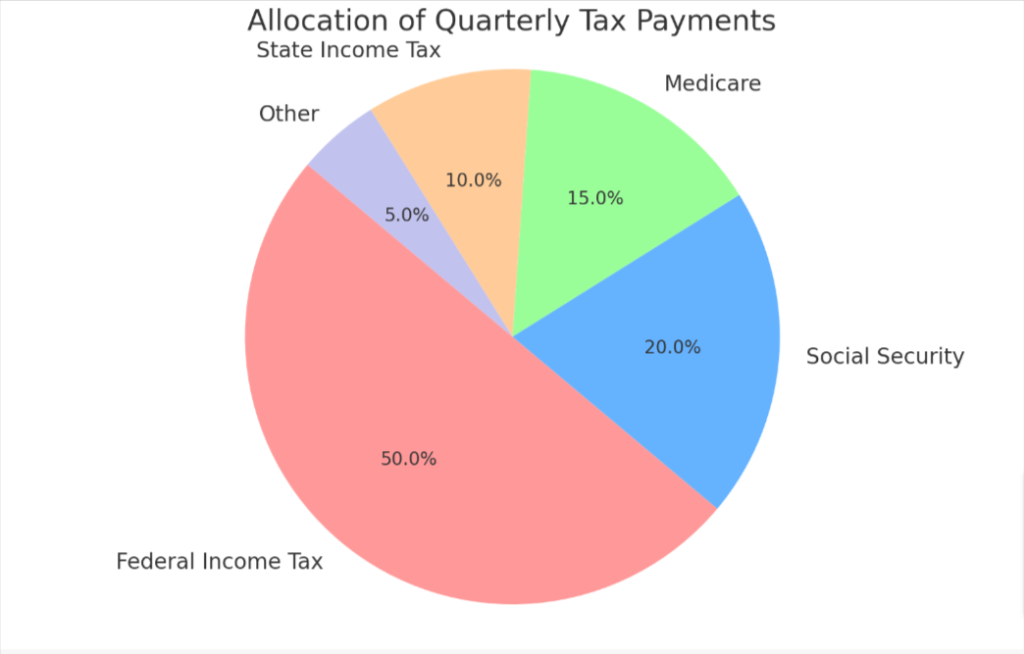Mastering Quarterly Taxes: A Timely Guide for the Self-Employed
Are you grappling with the complex issue of paying your quarterly taxes? In 2021, it is estimated that over 5 million Americans failed to make their correct quarterly tax payments.
This article offers an easy-to-follow guide on why, when, and how to avoid any penalties by staying on top of your game. Intrigued? Dive in!
Key Takeaways
- Quarterly taxes are a method of paying income taxes throughout the year rather than all at once during tax season.
- Self – employed individuals, 1099 workers, businesses with employees, and investors are among those who should pay quarterly taxes.
- It is crucial to know the specific due dates for each quarter and to calculate and submit your payments accurately using IRS forms or online resources.
What are Quarterly Taxes?
Quarterly taxes are a method of paying income taxes on a quarterly basis rather than all at once during tax season.
Definition and purpose
Quarterly taxes, also known as estimated tax payments, serve a significant purpose in the U.S. taxation system. They act as a pay-as-you-go method where taxpayers cover their tax liabilities throughout the year rather than paying all at once during tax season.
This system primarily benefits individuals such as self-employed workers, entrepreneurs, and investors who don’t have taxes withheld from their income by an employer. It helps to keep their financial obligations manageable and predictable instead of facing a hefty bill in April.
Overall, quarterly taxes function to smooth out the process of taxation for both taxpayers and authorities.
Who is required to file
The obligation to file quarterly taxes extends to a specific group of taxpayers. These include:
- Self – employed individuals who operate their own businesses make estimated tax payments. They might be freelancers, consultants, or owners of small businesses.
- 1099 workers fall into the category. These folks work as independent contractors and must calculate their own tax obligations.
- Businesses with employees have to manage withholding taxes from payroll and pay their portion of employment taxes.
- Investors are also included, especially those who earn substantial taxable income from their investments.
- Individuals who owed more than $1000 on last year’s tax return need to make estimated payments this year to avoid penalties.
Implications of not paying
Let’s be clear: missing quarterly tax payments can land you in hot water with the IRS. The implications of not paying your estimated taxes are indeed severe. Taxpayers who fail to pay their full quarterly taxes may face penalties, accruing from the day the payment was due until it is fully paid.
The IRS is firm about tax collection and late payments. Not only do these fines add up quickly, but they also compound over time. If you ignore your tax liability for too long, more dire consequences such as wage garnishments or liens on property could become a reality.
Additionally, persistent non-payment could even trigger an audit by the IRS. It’s evident that fulfilling tax obligations promptly and accurately is crucial to avoid potential financial and legal ramifications.
When and How to Pay Quarterly Taxes
Quarterly taxes must be paid by specific due dates throughout the year, and there are different methods to calculate and submit these payments.
Due dates for 2023
In the year 2023, the IRS has designated specific dates for the payment of quarterly taxes. These due dates are vital to know so you can make your payments timely and avoid penalties. Here is the schedule:
| Quarter | Income Period | Due Date |
|---|---|---|
| 1st Quarter | January 1 – March 31 | April 15, 2023 |
| 2nd Quarter | April 1 – May 31 | June 15, 2023 |
| 3rd Quarter | June 1 – August 31 | September 15, 2023 |
| 4th Quarter | September 1 – December 31 | January 15, 2024 |
Each quarter covers a specific income-earning period, and payment is due not long after that period ends. It’s crucial to mark these dates on your calendar and ensure you are prepared to make your payments on time.
Calculation and payment methods
Calculating and paying your quarterly taxes is an important part of managing your finances. It helps ensure that you stay on top of your tax obligations throughout the year. Here are some key methods to consider:
- Use last year’s taxes as a guide: Start by reviewing your previous year’s tax return to estimate how much you might owe for the current year.
- Divide the total amount into four payments: To stay consistent, divide your estimated taxes into equal amounts over the four payment periods.
- Pay online or through paper forms: You can make your quarterly payments electronically using the IRS’s online payment system, or you can mail in paper forms with a check or money order.
- Utilize IRS Form ES: You’ll need to use Form ES (Estimated Tax for Individuals) to report and pay your estimated taxes. This form will help you calculate how much you owe for each quarter.
- Stay aware of due dates: Make sure you’re aware of the specific due dates for each quarterly payment period based on when income is earned.
Who Should Pay Quarterly Taxes?
Self-employed individuals, 1099 workers, businesses with employees, and investors are among those who should pay quarterly taxes.
Self-employed individuals
Self-employed individuals have the responsibility of paying quarterly taxes to the IRS. This includes freelancers, contractors, and small business owners who earn income without having taxes withheld from their paychecks.
As a self-employed individual, you are required to estimate your tax liability for the year and make four equal payments throughout the year. These estimated tax payments help you stay current with your tax obligations and avoid penalties for underpayment.
To determine your quarterly tax amount, you can use the previous year’s taxes as a guide or calculate using Form 1040-ES provided by the IRS. It’s important to keep track of deadlines for each quarter and submit your payments either online or through paper forms designated by the IRS to ensure compliance with tax regulations.
1099 workers
1099 workers, also known as independent contractors, are individuals who work for themselves and receive income from multiple clients or sources. These workers are responsible for calculating and paying their own taxes since they do not have taxes withheld from their paychecks like traditional employees.
As a 1099 worker, it is essential to understand your tax obligations and make quarterly estimated tax payments based on the income you earn throughout the year. By doing so, you can avoid penalties and ensure that you fulfill your tax responsibilities in a timely manner.
Businesses with employees
Businesses with employees have additional responsibilities when it comes to paying quarterly taxes. In addition to calculating and submitting their own tax payments, they must also withhold income taxes from their employees’ wages.
This means that businesses need to stay updated on the current tax rates and ensure that the correct amount is being withheld from each employee’s paycheck. It’s important for businesses to understand these obligations in order to avoid penalties and comply with IRS regulations.
By staying organized and keeping accurate records, businesses can effectively manage their quarterly tax obligations while fulfilling their role as employers.
Investors
Investors, whether they are individuals or businesses, may need to pay quarterly taxes depending on their income and tax obligations. If you earn income from investments such as stocks, bonds, or real estate, you may be required to make quarterly estimated tax payments.
This ensures that you’re paying your fair share of taxes throughout the year rather than waiting until tax season. By estimating your tax liability and making regular payments, you can avoid penalties for underpayment and stay on top of your tax obligations.
Remember to consult with a professional or refer to IRS resources for guidance specific to your investment situation.
Tips and Resources for Paying Quarterly Taxes
- Adjust withholding or estimated tax payments to avoid underpayment penalties.
- Familiarize yourself with the penalties for not paying on time to ensure compliance.
- Utilize useful publications and forms provided by the IRS for guidance.
- Consider seeking professional help from a tax expert or accountant for accurate payment calculations.
- Explore online tax software options that can streamline the process and provide accurate estimates.
- Stay updated on changes in tax laws and deadlines to prevent any surprises when it’s time to pay.
Changing withholding or estimated tax payments
To ensure you’re meeting your tax obligations, it’s important to periodically review and adjust your withholding or estimated tax payments. If you’ve experienced changes in your income or expenses throughout the year, modifying these payments can help you avoid any surprises when it comes time to file your taxes.
By staying proactive and adjusting your withholdings or estimated payments as needed, you can ensure that you’re paying the correct amount of taxes throughout the year and avoid any potential penalties for underpayment.
Penalties for not paying on time
Failing to pay your quarterly taxes on time can result in penalties from the IRS. If you don’t meet the deadlines for making estimated tax payments, you may be subject to a penalty based on the amount owed and how late your payment is.
These penalties are calculated based on interest rates set by the IRS and can add up quickly if left unpaid. It’s important to stay organized, keep track of due dates, and make your payments in a timely manner to avoid these penalties.
Useful publications and forms
To make the process of paying quarterly taxes easier, there are several useful publications and forms available. These resources can provide guidance and assistance in managing your tax obligations. Here are some helpful publications and forms to consider:
- IRS Publication 505: This publication provides information on how to calculate and pay estimated taxes. It offers a detailed explanation of the requirements for individuals who need to make quarterly tax payments.
- IRS Form 1040-ES: This form is used to calculate and pay estimated taxes. It helps you determine the amount of tax you owe for each quarter and provides instructions on how to make your payment.
- IRS Form W-4: If you are an employee, this form is used to adjust your withholding allowances. By accurately completing this form, you can ensure that enough taxes are withheld from your paycheck throughout the year.
- Electronic Federal Tax Payment System (EFTPS): EFTPS is a secure online system provided by the IRS that allows taxpayers to make federal tax payments electronically. It’s a convenient option for submitting your quarterly tax payments.
- IRS Tax Withholding Estimator: This online tool helps you determine the appropriate amount of taxes to withhold from your paycheck or pay in estimated taxes. It takes into account various factors such as income earned, deductions, and credits.
- State-specific resources: In addition to federal taxes, some states may have their own requirements for quarterly tax payments. Check with your state’s department of revenue or taxation for any specific publications or forms related to state income taxes.
Seeking professional help
If you find yourself overwhelmed or unsure about how to navigate the world of quarterly taxes, it may be beneficial to seek professional help. Tax professionals, such as accountants or enrolled agents, can provide guidance and ensure that you are filing your taxes correctly and on time.
They can also help you understand any changes in tax laws that may affect your quarterly tax obligations. By working with a professional, you can have peace of mind knowing that your taxes are being handled properly and avoid potential penalties for incorrect filings.
Online tax software options
With the advancement of technology, there are several online tax software options available to help with the calculation and payment of your quarterly taxes. These platforms range in price, features and usability. Here’s a summary of some popular choices:
| Software | Cost | Features |
|---|---|---|
| TurboTax | Free to $200 | Easy-to-use interface, thorough error checking, and extensive support resources. |
| H&R Block | Free to $145 | Robust tax planning tools, excellent customer service, and physical locations for in-person support. |
| TaxAct | Free to $79.95 | Reliable and affordable option with an array of tools for both simple and complex returns. |
| FreeTaxUSA | Free to $14.99 | Excellent for those looking for a budget-friendly solution with support for most tax situations. |
Remember to carefully compare features and costs before choosing the best option for your tax filing needs.
Staying updated on tax laws and deadlines
Staying updated on tax laws and deadlines is crucial for ensuring that you meet your tax obligations in a timely manner. Tax laws can change frequently, so it’s important to stay informed about any updates that may affect your filing requirements or deductions.
By staying up-to-date, you can avoid penalties and fines associated with non-compliance. Additionally, being aware of tax deadlines allows you to plan ahead and make necessary adjustments to ensure that you submit your tax payments on time.
Whether it’s through regularly checking the IRS website or subscribing to relevant newsletters or publications, staying informed will help you navigate the ever-changing landscape of tax laws and deadlines with confidence.

Conclusion
In conclusion, paying quarterly taxes is essential for individuals and businesses to meet their tax obligations. By staying up to date on deadlines, calculating and making payments accurately, and seeking professional help if needed, taxpayers can avoid penalties and ensure compliance with the IRS.
Paying as you go throughout the year helps to manage your tax liability effectively while avoiding any problems during tax time. Stay informed about changing tax laws and utilize resources such as online software or publications provided by the IRS to make the process smoother.

